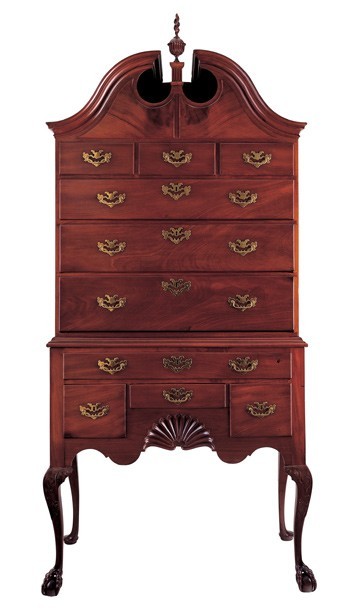

Detail of the signature on the back of the high chest illustrated in fig. 1. (Photo, Gavin Ashworth.)
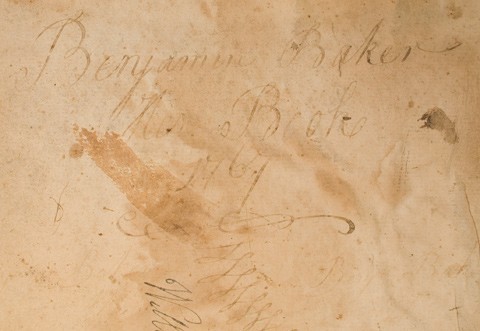
Detail of the front inside cover of the account book of Benjamin Baker. (Courtesy, Newport Historical Society)
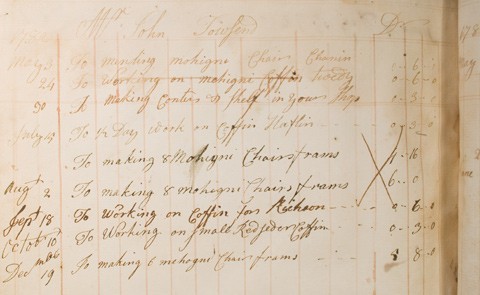
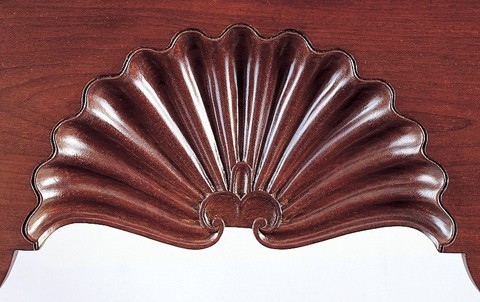
Detail of the carved shell on the skirt of the high chest illustrated in fig. 1. (Photo, Gavin Ashworth.)

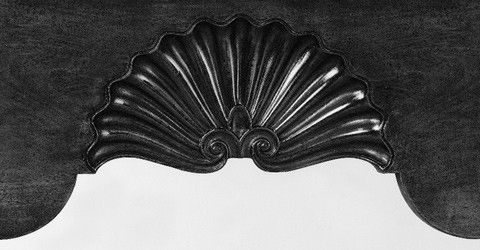
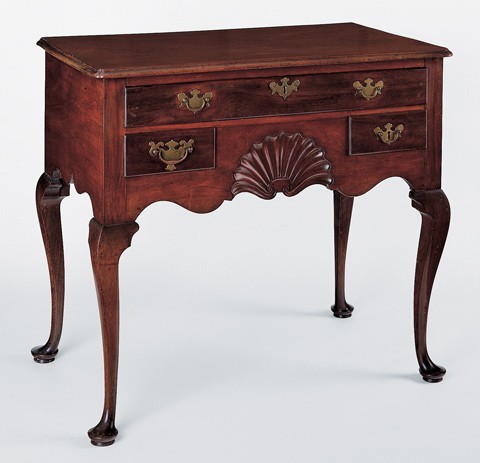
Benjamin Baker, dressing table, Newport, Rhode Island, possibly 1764. Mahogany with chestnut and white pine. H. 31", W. 35", D. 20". (Courtesy, Preservation Society of Newport County; photo, Gavin Ashworth.)
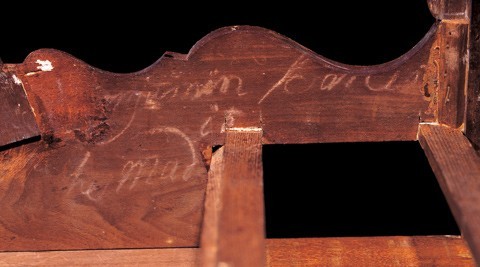
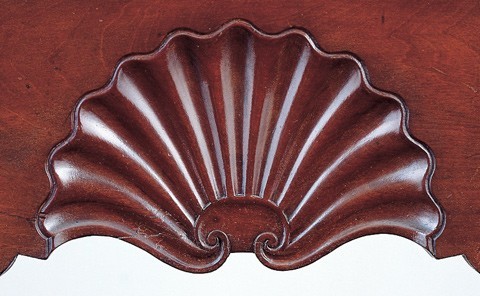
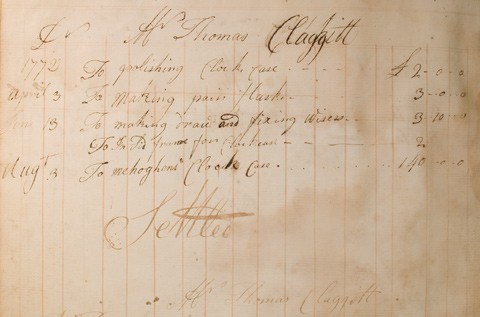
Entry for Thomas Claggett in the account book of Benjamin Baker.
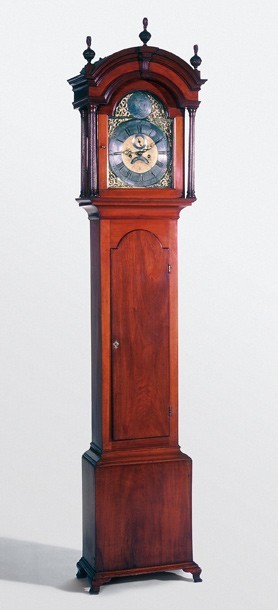
Benjamin Baker, tall clock case, Newport, Rhode Island, 1772. Mahogany with white pine. H. 95", W. 21 5/8", D. 11 1/4". (Courtesy, Old Sturbridge Village.)
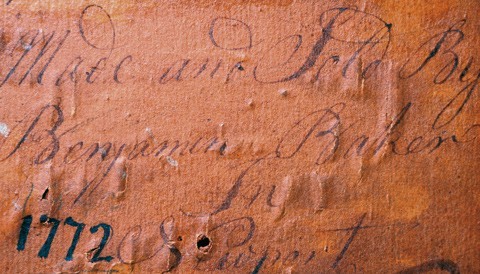
Detail of the label on the back of the waist door of the tall clock case illustrated in fig. 12.

Map of Newport showing Baker’s property on Easton’s Point, 1777. (Courtesy, Newport Historical Society.)
Until recently, Benjamin Baker's (ca. 1735—1822) exploits as an eighteenth-century Newport cabinetmaker were unknown even to the institution that now owns his account book. In a letter written to the Newport Historical Society in 1940, Antiques editor Alice Winchester reported that a descendant of Baker owned one of a set of six chairs that had come down in his family. Although the chair had been attributed to the later Newport cabinetmaker Thomas Goddard (1765—1858), Winchester asked if it could have been made by Baker. The society replied that the historical records concerning Baker's role in the cabinetmaking trade were unclear, leading Winchester to respond that "there seems to be little indication that he was himself a cabinetmaker, and it may well be that he really had nothing to do with making the so-called Goddard chair." Had the society been aware of the contents of Baker's account book, the organization would almost certainly have replied that he was a cabinetmaker who produced a significant number of chairs.[1]
Regardless of the chair's current location or rightful attribution, this oft-told story has become a parable for the study of early Rhode Island furniture. Indeed, the field has become so obsessed with cabinetmakers from the Goddard and Townsend families that it has minimized the important contributions made by other Newport craftsmen and their contemporaries working throughout the Narragansett Bay region. More than five hundred cabinetmakers, joiners, turners, chair makers, and allied craftsmen were active there during the colonial period. Although most left little evidence of their lives and careers, Baker's activities are detailed in his account book and manifest in a small but revealing group of furniture. As a result, he is one of the most thoroughly documented cabinetmakers active in eighteenth-century Newport.
Baker's account book records his work as a cabinetmaker from 1760 to 1792. It lists an impressive array of forms, which range from simple pine bookcases and chests to expensive mahogany and black walnut chair frames, bureau tables, cases of drawers, clock cases, desks, fly tables, twilight tables, drop-leaf tables, and teaboards. Baker's patrons comprised the wealthiest segment of Newport's merchant class as well as local craftsmen and members of his own family. Baker also did piecework at various times for other Newport cabinetmakers that included turning pillars and constructing joints for tables. His accounts show him to be a prolific and versatile craftsman who pursued various woodworking activities such as house and ship carpentry. His most active period as a furniture maker was from the 1760s through the mid-1770s. During Newport's subsequent economic decline in the late eighteenth century Baker relied more heavily on day labor and odd jobs for income (see table 1).
Previous studies of Newport cabinetmakers have broadened our understanding of the furniture-making trade prior to the American Revolution. Jeanne Vibert Sloane's groundbreaking examination of the accounts of John Cahoone (ca. 1725—1792) demonstrated that trade in venture cargo was vital to Newport's economy and that the town's cabinetmakers and merchants were able to challenge their competitors in other New England cities. Between 1750 and 1759 Cahoone focused his production on plain, standardized forms, such as desks and tables, intended for the export market, rather than on high-style furniture for local consumption. Martha Willoughby's analysis of the surviving ledger (1750—1759) and daybook (1762—1778) maintained by Job Townsend Jr. (1726—1778) and his son Job E. (1758—1829) reveals a similar pattern. Like many other urban tradesmen, the Townsends maximized their income by specializing in a limited range of forms, primarily tables and desks. By comparison, Baker's accounts prior to the Revolution reveal that he had a smaller shop and produced less furniture in general. He appears to have achieved success by making limited quantities of "plain" furniture appropriate for local patrons and consumers in export markets.[2]
During the period covered by his account book, Baker produced 128 chairs, 21 case pieces, 21 tables, 8 stands, 6 teaboards, and smaller numbers of other objects. Although he made chairs in sets, the number of orders for seating (20) was greater than those for any other furniture form. Of the seating forms, 122 were side chairs (62 mahogany, 40 maple, and 20 black walnut), 4 were mahogany close stools, and 2 were mahogany corner or roundabout chairs. For side chairs, he charged as little as £14 for maple and between £32 and £56 for mahogany examples.
More than any other known Newport cabinetmaker, Baker specialized in chairs, particularly during the earliest years of his career. Willoughby's analysis of Job Townsend Jr.'s account books for the years 1762 to 1776 shows a similar specialization in tables, which amounted to approximately half of his credit income, followed by desks (20%), teaboards (6.6%), and seating furniture (4.8%). Sloane posits that for most Newport cabinetmakers specialization reflected the demand of export markets. In the case of John Cahoone, his specialization in desks and tables during the period 1750—1759 matched demand in specific American ports during those years. Although insufficient evidence survives to compile accurate shipping records prior to 1769, the Imports and Exports Ledger kept by the British colonial government provides counts of total recorded furniture exports from Rhode Island between the years 1769 and 1772. Anne Rogers Haley's research into these records dramatically alters the perception of Newport's exports during these years. On average, Rhode Island shipped 512 chairs per year to its export markets (coastal trade and the West Indies) as compared to 217 desks and other case forms and 110 tables. Baker's production totals, although somewhat earlier in the 1760s when the British shipping records are less complete, fall more in line with this total market demand.[3]
The gradual "rediscovery" of Baker's career and work has been serendipitous. The high chest illustrated in figure 1 was attributed to John Goddard (1723—1785) when it sold at Parke-Bernet Galleries in 1971. According to oral tradition, Goddard made the piece for a member of the Lyman Hazard family of Peacedale, Rhode Island. Fortunately, Baker's name was subsequently found, written upside down on the back of the lower case (fig. 2).[4]
The writing is similar to that in Baker's account book (see figs. 3, 4), but his role in the construction of the high chest remains unclear. In many respects, the piece is more typical of examples associated with other Newport cabinetmakers, particularly John Townsend (1732—1809). The stylized leaf carving on the knees and fleur-de-lis element of the shell on the skirt (fig. 5) have parallels on two other high chests, including one signed and dated by Townsend (figs. 6, 7). Several explanations for Baker's inscription exist. No high chests are listed in his account book, but it is still plausible that he made this example using components purchased from Townsend. Newport case furniture was particularly well suited for piecework, which gave the city's cabinetmakers a competitive edge in the export market. Alternatively, Townsend could have commissioned Baker to make the carcass and had the carving and finish details completed in his shop. Newport cabinetmakers occasionally collaborated on projects. For example, Job Townsend Jr. and his brother Edmund made a desk for Nicholas Anderrese in 1767. It is also possible that Baker simply repaired a high chest made by John Townsend and wrote his name on the back when the job was completed.[5]
Baker's account book does indicate that he had a professional relationship with John Townsend after the Revolution. From May to June 1782 Baker recorded charges to Townsend for making twenty-two mahogany chair frames, repairing a mahogany chair, working on coffins, and making a counter and a shelf for the shop (see fig. 4). By that time, Baker had lived near Townsend for at least eighteen years. The former's house and shop was located on lot 93 at Easton's Point, an area with a large population of tradesmen.[6]
The signature on the dressing table illustrated in figure 8 is much less ambiguous than that on the high chest. Written in chalk on the back of the front skirt, the inscription reads "-enjamin Baker / he mad it" (fig. 9). Baker signed the mahogany board before it was cut, then inserted the word "it" above the joint where the drawer supports meet the front.[7]
This dressing table may be the "Low Draws" for which Baker debited Newport goldsmith Jonathan Otis £75 on July 3, 1764. The same order also included eight maple chair frames and one maple tea table. Otis was a frequent customer, purchasing a mahogany "fly table" in November 1762 and a mahogany dining table in January 1766.[8]
The dressing table is a relatively plain example of Newport work, with undecorated cabriole legs, pad feet, and a simple eleven-lobed shell surrounded by an incised line (fig. 10). Visually, the darker variety of mahogany used for the legs, leg facings, and drawer fronts contrasts with the lighter mahogany of the skirt that they frame and punctuate. This use of contrasting shades of mahogany occasionally occurs on other examples of Newport furniture, including another object made by Baker. Unlike the high chest illustrated in figure [1], the dressing table has construction details that deviate from John Townsend's early work. The long, horizontal drawer blade dovetailed to sides of the case creates a jarring visual break above the shell, whereas in most Newport dressing tables the skirt is rabbeted over the front of the drawer blade. Another unusual feature is the use of a toothing plane to level the backs of the drawer fronts. These characteristics may allow future furniture scholars to identify other examples of Baker's work.
Baker's account book indicates that he also did contract work for craftsmen. On August 3, 1772, he made for Newport clockmaker Thomas Claggett (ca. 1730—1797) a mahogany case valued at £140 (fig. 11). This last entry probably refers to the mahogany tall clock case illustrated in figure 12. Once part of the J. Chaney Wells collection, this clock has a handwritten paper label on the inside of the door that reads "Made and Sold By Benjamin Baker In Newport 1772" (fig. 13). Like the aforementioned dressing table, the clock case's visual appeal comes from its clean lines and contrasting mahogany primary woods. A note signed by Claggett remains with the clock. Dated December 30, 1772, it states: "Thomas Claggett Do Warrant a Clock to Abraham Brown to be A good Clock if she Dues not prove So I promis to Pay the money back to sd Brown whis is fifty six dollars & on [e] quarter Witness my hand Thomas Claggett." Although Baker made mahogany clock cases for Caleb Allen in 1765 and Isaac Eleazer in 1766, no others are listed in his account book in 1772.[9]
Most studies of colonial Rhode Island cabinetmaking have focused on ornate tables and block-and-shell-carved furniture presumably made for local consumption or simpler wares produced for the export market. The vast majority of surviving furniture is relatively plain, but there is less of a dichotomy between these two levels of production than traditional scholarship suggests. The dressing table and clock case made by Baker indicate that plain work had currency at a certain level of the Rhode Island market. During his career, Baker produced more expensive mahogany furniture, including a "full hed desk" and a bureau table for approximately £300 each. As was probably the case with many of his competitors, Baker's production varied greatly as he endeavored to accommodate the tastes and needs of a diverse clientele.[10]
Despite the survival of Baker's account book and signed work, surprisingly little is known about his personal life. His birthplace, date of birth, and parents' names remain a mystery. Baker married Martha Simpson (ca. 1735—1815) in Newport on January 28, 1759. She and their children Susan, John, and William are listed in his account book, as are Baker's sons-in-law Henry Howland and shipwright Henry Goddard, who married another daughter, Ellenor. In 1764 Baker entered a suit in the Newport County Court of Common Pleas for twenty-five shillings rent due on a dwelling house and lot known as number 93 on Easton's Point (fig. 14). In the case, which was appealed all the way to the Newport County Supreme Court of May 1765, Baker was listed as a "cabinet maker." In 1821 the widower Baker bequeathed the property to his daughter Ellenor, whose husband acted as the executor of his estate.[11]
Like other Newport cabinetmakers of his era, Baker engaged in the furniture export trade. In the December 8, 1849, issue of the Newport Daily Advertiser, historian Thomas Hornsby noted:
All the cabinetmakers on Bridge and Washington Streets, employed a large number of hands, manufacturing furniture, for which a ready market was found in New York and the West Indies. The stores of David Huntington and Benjamin Baker were also on the Point; both these men were extensively engaged in manufacturing furniture, which they shipped to New York, and the West Indies.
Baker's location on Elm Street gave him easy access to the wharfs that lined Newport's western harbor. Although no other records allude to Baker's role in the export trade, entries in his account book mention "casing" furniture. Baker made cases for a mahogany card table and chest of drawers for silversmith Samuel Brenton in 1762, two red cedar desks and a maple desk for William and Joseph Wanton in 1764 and 1766, two maple desks for Aaron Lopez in 1771, and a bureau table and six mahogany stands for Myer Pollack in 1774 and 1775. Other than Brenton, all of these patrons were merchants engaged in the venture cargo trade. Although the furniture listed in these entries is typical of that shipped from Newport to the other American colonies and the West Indies, the relatively small number of orders cannot account for the renown Baker achieved as an exporter. His reputation may have emanated from his credit accounts with this group of merchants, which listed many pieces of furniture Baker purchased, presumably from other Newport makers.[12]
With the exception of one "nest of drawers" made for Dr. Knowles, Baker's work after the Revolution was exclusively for other cabinetmakers: John Townsend, Walter Nichols (1748—1823), and Eleazer Trevett (1715—ca. 1804). In 1786 Baker supplied Nichols with three bureaus (or desks) for a total of £9.18. He also charged him for "helping on [a] Bed sted," making components for a clock case, and turning two pillars. The pillars must have been for fly tables since Baker included a charge for setting in the legs. For Trevett, who was also active in the venture cargo trade, Baker made nine pairs of joints, or hinges, for the rails of tables and a set of turned legs. The reason for the latter's shift from making furniture to producing piecework is unknown; it may have been motivated by Newport's precipitous economic decline after the Revolutionary War or personal reasons. During this period Baker also began to rely more heavily on day labor and ship carpentry for income, as indicated by his debits to Captain Moore of the brigand Hope and Captain Joseph Garner of the sloop Salley, both in 1783. Baker's last entry for furniture lists a teaboard he sold to William Potter in March 1792. The following month Baker began renting a room at the home of merchant Simeon Martin on Thames Street. The Rhode-Island Republican records his last residence "at the home of the widow Helme, near the North Battery." Baker died on Sunday, January 6, 1822, at the age of eighty-seven.[13]
Baker's later history is typical of other Newport cabinetmakers forced to pursue odd jobs that took advantage of their woodworking skills during the last two decades of the eighteenth century. His career as a shop joiner or cabinetmaker before the Revolution, however, gives insight into the Newport furniture-making trade at its height, when the cabinetmaking shops on the Point bustled with activity and their wares reached distant markets along the Atlantic seaboard and into the Caribbean. Baker's "plain" style was well suited to the export market and met the demands of local consumers who were either unable or unwilling to purchase more elaborate forms. His documented dressing table and clock case represent a very limited sampling of the overall production of his shop as compared with his much larger output of chairs, tables, and desks during the same period. Tantalizing suggestions of other surviving examples of Baker's furniture as well as gaps in his biography hold promise for further discoveries about this largely overlooked Newport cabinetmaker.
ACKNOWLEDGMENTS
For their kind assistance with this article, the author thanks John Bartosh, Edward S. Cooke Jr., Erik Gronning, Anne Rogers Haley, Patricia E. Kane, Rebecca Kelly, Bert Lippincott, Michele Musto, Ron Potvin, Pieter Roos, Adams Taylor, Martha Willoughby, and Joan Youngken.
Appendix
This appendix is formatted to be a companion to Martha Willoughby's transcription of the account book of Job Townsend Jr. published in the 1999 volume of American Furniture. Baker's account book is not complete owing to missing pages. No record of his furniture production exists for the years 1767—1769.
Alice Winchester to Mrs. Sherman, September 11, 1940; Herbert O. Brigham (librarian of the Newport Historical Society [hereafter cited NHS]) to Alice Winchester, September 30, 1940; and Alice Winchester to Herbert O. Brigham, October 15, 1940, Baker genealogy file, NHS. The author thanks Ron Potvin for sharing this story and the pertinent references. George H. Richardson (1838—1916) records the brief entry "Benj Baker, at the Point" in his list of "Furniture Makers or Cabinet Makers" within his larger manuscript, "Occupations: Craftsmen in Newport, And other Information about the Town's Inhabitants," G.H.R. scrapbook no. 982, p. 29, NHS. Baker is mentioned as a Newport cabinetmaker in Ethel Hall Bjerkoe, The Cabinetmakers of America (Garden City, N.Y.: Doubleday, 1957), p. 36. Baker was described as a "Joiner" in an October 9, 1777, account in Dr. William Hunter's Physician's Book (453), p. 25, NHS.
Jeanne Vibert Sloane, "John Cahoone and the Newport Furniture Industry," in New England Furniture: Essays in Memory of Benno M. Forman (Boston: Society for the Preservation of New England Antiquities, 1987), pp. 88—122. Martha H. Willoughby, "The Accounts of Job Townsend, Jr.," in American Furniture, edited by Luke Beckerdite (Hanover, N.H.: University Press of New England for the Chipstone Foundation, 1999), pp. 109—61.
Wendy A. Cooper, In Praise of America: American Decorative Arts, 1650—1830 (Washington, D.C.: National Gallery of Art, 1980), p. 27. Charles J. Burns, "The Newport Legacy of Miss Doris Duke: A History of the Newport Restoration Foundation and a Catalogue of Its Collection at the Samuel Whitehorne Museum" (master's thesis, Trinity College, 1995), cat. no. 33. Parke-Bernet Galleries, Important 18th Century American Furniture and Decorations, New York, May 22, 1971, lot 199. The high chest is also illustrated on the cover of this catalogue.
Cooper, In Praise of America, pp. 27—28. Cooper suggests that Baker may have had a hand in making the high chest; however, she questions the location of the signature. Michael Moses, Master Craftsmen of Newport: The Townsends and Goddards (Tenafly, N.J.: MMI Americana Press, 1984), p. 194. At the end of his chapter on the work of John Townsend, Moses includes detailed photographs of the high chest illustrated in fig. 1 in comparison to similar views of two other high chests, one made by John Townsend and another attributed to him. Jeanne Vibert Sloane attributes the high chest illustrated in fig. 1 to Baker ("John Cahoone," p. 92 and fig. 1). In his master's thesis on the Doris Duke collection, Charles Burns questions the traditional attribution of the high chest to John Goddard, noting the formal similarities to John Townsend's work. He stops short of attributing the object to Townsend, however, citing the presence of the Baker signature and the collaboration between the two cabinetmakers noted in the Baker account book (Burns, "The Newport Legacy of Miss Doris Duke," cat. no. 33). Similarly, Gerald W. R. Ward suggests that both Townsend and Baker may have collaborated on the chest in "‘America's Contribution to Craftsmanship': The Exaltation and Interpretation of Newport Furniture," in American Furniture, edited by Luke Beckerdite (Hanover, N.H.: University Press of New England for the Chipstone Foundation, 1999), p. 233, fig. 6. In addition to the high chest signed and dated by John Townsend, the following pieces have carved shells with fleur-de-lis motifs: a high chest at the Museum of Fine Arts, Boston; a signed and dated document chest in the collection of the Chipstone Foundation; and a three-shell bureau in the Diplomatic Reception Rooms, U.S. Department of State. Willoughby, "The Accounts of Job Townsend, Jr.," p. 115.
Townsend's ownership of property on the Point in Newport is discussed in Moses, Master Craftsmen, pp. 65, 67.
The dressing table is illustrated in Ralph E. Carpenter Jr., The Arts and Crafts of Newport, Rhode Island, 1640—1820 (Newport, R.I.: The Preservation Society of Newport County, 1954), cat. no. 61. It was later purchased by the Preservation Society from its owner, Mrs. Philip G. Birckhead. She was a descendant of William Hunter, Esq., the owner of the house on Washington Street in Newport where the object is now displayed.
Philip Zea and Robert C. Cheney, Clock Making in New England, 1725—1825: An Interpretation of the Old Sturbridge Village Collection (Sturbridge, Mass.: Old Sturbridge Village, 1992), pp. 14—15, 163. The clock descended in the family of its original owner, Abraham Brown of Tiverton, Rhode Island. The clock is also discussed in Richard Champlin, "Thomas Claggett: Silversmith, Swordsman, Clockmaker," Newport History 49, no. 163 (summer 1976): 60—62. Baker's accounts with Claggett are mentioned briefly in Richard L. Champlin, "William Claggett and His Clockmaking Family," Newport History 47, no. 155 (summer 1974): 182.
Death notice for Benjamin Baker, Rhode-Island Republican (Newport), January 9, 1822. The marriage of Benjamin Baker and Martha Simpson at the Second Congregational Church in Newport on January 28, 1759, is recorded in James N. Arnold, Vital Records of Rhode Island, 1636—1850, 21 vols. (Providence, R.I.: Narragansett Historical Publishing Company, 1896), 8: 458. James Easton et al. v. Benjamin Baker, Newport County Court of Common Pleas, May term 1764, case 214, Record Book G, pp. 271, 305. The case was appealed to the Newport County Supreme Court and heard during the May term 1765, Record Book E, p. 276. The case was appealed to "the King in Council in Great Britain" and "refused by the Court, for that it doth not appear to them that the Title of the Land is in dispute but the Rent only." A deed in the Newport City Hall records the sale of lot 93, Second Division, on Easton's Point to Benjamin Baker, "Cabinet Maker" of Newport, on June 10, 1800 (Proprietors of Easton's Point to Benjamin Baker, May 10, 1800, Newport Land Evidence, vol. 12, p. 102). Baker bequeathed this lot on Elm Street to his daughter Ellenor, wife of Henry Goddard (Will of Benjamin Baker, December 5, 1821, Newport Probate Records, vol. 11, p. 117). Goddard was the executor of Baker's estate. The latter's heirs sold this land to Francis L. Tripp (Susan Howard et al. to Francis L. Tripp, April 10, 1846, Newport Land Evidence, vol. 26, pp. 283—84). The "Goddard" chair passed down in the family of Benjamin Baker's daughter Susan (m. Henry Howland). Likewise, the inventory of Baker's son William lists a large percentage of furniture that may give further insight into Baker's production: "One Mahogany Desk $20. Two Mahogany Card Tables $20. One Dining Table $4 / Eight Chairs Hair Bottoms $12. One large looking glass $10. One small ditto $5 / Two Tables and one Stand $7. Eleven Chairs $6 . . . / . . . One Table and One Chest $1.50 / One Small Writing Desk $4. Three Bedsteads and Bedding $175" (Inventory of William H. Baker, December 15, 1803, Newport Probate Records, vol. 4, p. 114).
Thomas Hornsby, "Newport, Past and Present," Newport Daily Advertiser, December 8, 1849, as quoted in Sloane, "John Cahoone," p. 92. This quote is repeated in George Champlin Mason, Reminiscences of Newport (Newport: Charles E. Hammett Jr., 1894), p. 49; and Carpenter, The Arts and Crafts of Newport, p. 9. Sloane, p. 104, argues that Newport cabinetmakers commonly exported red cedar desks, whereas there is little evidence for this type of desk being used locally. Baker also sold a "Redseder Desk" to William Wever in 1775. A May 18, 1785, receipt with Baker's signature and a credit for repairing a mahogany bedstead for Joseph Lopez is in the Aaron Lopez Papers, box 168, folder 6, NHS.
Baker's whereabouts during the Revolution are not recorded in his account book. A cryptic note in the Rhode Island State Archives records: "John Mowry bill for food and drink delivered to Benjamin Baker by order of John Northup and B Gardner," December session 1776, C#0292—General Treasurer: Accounts Allowed—Rhode Island State Archives. A letter written to His Excellency the Commander and Chief at Newport included Benjamin Baker among a list of subscribers who, "being Absent from our Familiys [sic] at the Time of the Emancipation of Newport," sought admittance to the city (Rhode Island State Archives, List of Persons Permitted to Reside in the State, December 2, 1779, Council of War—Letters and Accounts, vol. 1, p. 128). Baker's association with Newport joiner Thomas Atwood is indicated by an October 1761 account entry for one barrel of flour, £30.8, that the former gave the latter. Sampson Shearman v. Thomas Atwood, Newport County Court of Common Pleas, November term 1762, case 259. Death notice for Benjamin Baker: "DIED, In this town, on Sunday last, Mr. Benjamin Baker, aged 87. Funeral from his late dwelling, at the house of the widow Helme, near the North Battery, this afternoon, at 2 o'clock. Relations and friends are invited to attend without further notice." Another death notice for Baker appeared in the Newport Mercury, Saturday, January 12, 1822, vol. 61, no. 3118. The death of his wife, Martha, on December 26, 1815, at age 80, is recorded in the Rhode-Island Republican, Newport, Wednesday, January 17, 1816, vol. 7, no. 42.
